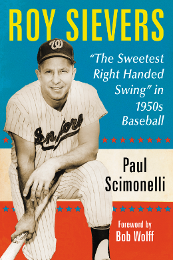Nationals fans are hopeful again, with the club coming off 6-1 road trip and threatening to return to the top of the National League East standings. One key has been the powerful bat of Matt Adams, who homered seven times in five games from May 1 through the May 7 win over San Diego.
A weekly slash line of .400/.516/1.240 is impressive for the 6-3,245-pounder known as “Big City,” but it brings to mind an even bigger streak by an even bigger man.
Frank Howard, the 6-7, 280-pound “Capital Punisher,” set baseball on its ear 50 years ago this week with the most prodigious display of power ever seen to that date.
Several players had produced six-game home-run streaks before 1968, including Hall-of-Famers Lou Gehrig, Roger Maris and Willie Mays (twice) and Senators hero Roy Sievers, and the Pirates’ Dale Long homered in eight straight in 1956. But Howard’s home-run binge dwarfed them all. From May 12 through May 18, Howard not only homered in every game, but he belted 10 home runs in 20 plate appearances, driving in 17. His line for the six games: .542/.560/1.833.
Howard, a former National League Rookie of the Year with the Los Angeles Dodgers, came to Washington three years earlier in a seven-player deal that included pitcher Claude Osteen going to the Dodgers. He endeared himself to fans by hitting monster shots into the upper deck of D.C. Stadium, later re-named in honor of the slain Sen. Robert F. Kennedy.
The national upheaval that included Kennedy’s assassination in the summer of 1968 had exploded that spring, following the April 4 assassination of Martin Luther King Jr. The tragic events cast a pall over the nation. Several ballparks were in the midst of the civil unrest, and D.C. Stadium was a staging area for National Guard troops assigned to contain the violence in the nation’s capital. At the demand of many players, baseball’s opening day was pushed back from April 8 to April 10.
The Senators were not good that year. After improving under manager Gil Hodges, they had traded the skipper back to the New York Mets in the offseason. New manager Jim Lemon, a slugger with the Senators of the 1950s, taught Howard an uppercut swing that increased his power output, but even that could not stop the team from sinking back to the bottom of the American League in the final season before the divisional alignment.
Howard’s tear began on May 12, a Sunday, with a relatively-large crowd of 13,200 gathered at D.C. Stadium to see the Senators take on the eventual pennant-winning Detroit Tigers. He led off the bottom of the sixth inning against lefty Mickey Lolich with a solo shot to start a five-run rally. The next inning, he added another homer off reliever Fred Lasher to complete the scoring in a 6-3 win.
After an off day, the Senators traveled to Boston. Howard hit a two-run homer off Ray Culp for a 2-0 first-inning lead and a solo shot off Lee Strange in the sixth for a 3-0 lead, but the Senators bullpen could not hold the lead, and they lost 5-4 in 10 innings.
The next night at Fenway, he again went deep in the first inning off righty Jose Santiago in a game Washington would lose 6-3.
The scene shifted to Cleveland, where Howard would face “Sudden” Sam McDowell, one of the hardest throwing lefties in the game, in cavernous Municipal Stadium. McDowell walked Howard with two outs in the first. But with a man on and two out in the third, the big guy hit his sixth homer in four games, staking Washington to a 2-0 lead. Two innings later, with a man on, Howard went deep again, and he had driven in every run of a 4-1 Senators victory.
A night later, the Senators were in Detroit’s cozy Tiger Stadium, and Howard waited until the top of the ninth to hit a two-run, go-ahead homer off starter Joe Sparma to put his team ahead 3-2. The Tigers won 7-3 on a walk-off grand slam.
The next day, Lolich was back on the mound for the Tigers, and Howard saved what might have been his best day of the streak for last. With two out and the score tied 1-1 in the top of the third, Howard went deep to put the Senators ahead for good. Two innings later, he hit his tenth homer in six games, a three-run shot that made it 5-1. He added a single in the seventh for good measure to finish 3-for-5 on the day.
The streak ended the next day when the Tigers swept a doubleheader and held Howard to a double in the opener and a single in the nightcap. Howard finished the season with 44 homers and 106 RBIs, both career highs to that point.
All the more impressive, Howard’s streak and career season came in “The Year of the Pitcher.” In 1969, the major leagues would lower the mound, shrink the strike zone and expand by four teams. Howard would say thanks by hitting 48 homers, driving in 111 and upping his average to a career-high .296 under the tutelage of Ted Williams.






